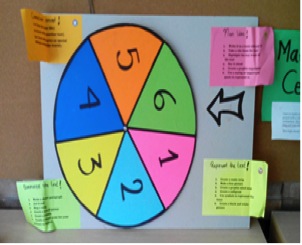23 de abril de 2018
Spin Wheel Games for Reading Comprehension Strategies
This article aims at describing the role of spin wheel games in introducing and applying seven strategies that boost reading comprehension in the EFL classroom. It offers insights into the definition of strategies and their difference from skills. Likewise, it presents the way spin wheel games can be used to introduce Reading Comprehension Strategies (RCS) and enhance students’ self-investment.
Paola Vargas Luna M.A.
This article aims at describing the role of spin wheel games in introducing and applying seven strategies that boost reading comprehension in the EFL classroom. It offers insights into the definition of strategies and their difference from skills. Likewise, it presents the way spin wheel games can be used to introduce Reading Comprehension Strategies (RCS) and enhance students’ self-investment.
Spin wheel games are pedagogical tools that promote language learning in the English classroom since they are “facilitators of knowledge and bring down tension and anxiety” (Camargo & Lacera, 2001, p. 9). The students feel motivated with this type of games since they provide different activities to opt for and accomplish. The uncertainty of upcoming activities when spinning the wheel increases motivation and decreases apprehension. Thus, it can be transferred to what Núñez (2010) propounded about games for language use when reading, “they give students the opportunity to use the language meaningfully and make the acquisition of input more likely” (p. 18). Hence, these games provide students with chances to know and consciously apply RCS that result in helping them to make sense of what they read, in a meaningful way.
The RCS abovementioned are deliberate actions the learners may use to interact with the text and construct meaning. Based on Cohen’s (1990) definition, they may differ from skills since they are not behaviors, but conscious actions that lead to reading comprehension. Indeed, according to Danner (2009), there are seven specific RCS to interact with the text: using prior knowledge, visualizing, making questions, inferring, determining importance, and summarizing. The first one, previous information, refers to the knowledge students have about the topic of the text; the second, visualizing, consists of creating or using images to understand; the third, making questions, embeds generating questions before and after reading; the fourth, inferring, entails the understanding of what is not explicitly stated; the fifth, determining importance, involves keeping the information that is required; finally, summarizing, encompasses the capacity of synthetizing the text.
Bearing the aforesaid ideas in mind, spin wheel games help teachers to introduce and apply these seven RCS in an innovative pedagogical way. This can be done by dividing the spin wheel into seven numbered parts, which correspond to each one of the strategies. The numbers should have a card where the teacher proposes different alternatives to communicate and express what the text suggests by applying each strategy; for instance, writing a paragraph, drawing a picture, creating a role play, writing and singing a song, and so forth. Requesting students to communicate what texts express is important since it supports one of the Second Language Acquisition (SLA) principles relevant to materials. As underscored by Núñez and Téllez (2009) they should “provide opportunities for communicative purposes in L2, fostering thereby language use” (p. 176). In other words, with the spin wheel game and its corresponding cards (as seen in the figure above), the teacher creates a learning environment where the students have chances to freely interact with the text in a different manner and express their interpretations.
For the reason above mentioned, using spin wheel games for reading comprehension in the EFL classroom is relevant because it “highly motivates, engages and arouses the interest…to learn English” (Anyaegbu, Ting & Li, 2012, p. 163), and it gives a purpose to the learning of English (Ávila, 2015, Deesri, 2002). Once students become aware of RCS, supported by the spin wheel games, and consciously apply them to written texts, they have more possibilities to become autonomous and strategic readers. This aspect equally fosters another SLA principle, whose purpose is to enhance self-investment; thence, learners start inquiring into and discovering the text self-sufficiently. In short, it is worth highlighting the different and motivating way in which spin wheel games present RCS; they also facilitate learners’ interaction with the text, and enhance their construction of meaning while having fun.
__________________________________________________________________________________________________
References
- Anyaegbu, R., Ting, W., & Li, Y. I. (2012). Serious game motivation in an EFL classroom in Chinese primary school. TOJET: The Turkish Online Journal of Educational Technology, 11(1).
- Ávila, H. A. (2015). Creativity in the English class: activities to promote EFL learning. How, 22(2), 91-103.
- Camargo, N. I., & Lacera, B. (2001). The fun approach to English learning. PROFILE: Issues in Teachers’ Professional Development, 2(1), 9-11.
- Cohen, A. (1990). Language learning. London: Heinle and H. publishers.
- Danner, C. (2009). Comprehension Connections: Bridges to Strategic Reading. [Power point slides]
- Deesri, A. (2002). Games in the ESL and EFL class. The Internet TESL Journal, 8(9), 1-5.
- Núñez, A., (2010). The teaching of English within the theory-practice alternance model. En: Innovación y Competitividad. Memorias de la Jornada de Investigación 2010. (pp. 32-54), Bogotá: Fundación Universitaria Empresarial de la Cámara de Comercio de Bogotá Uniempresarial


